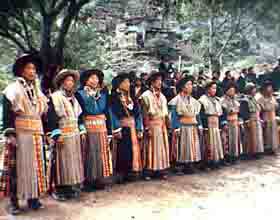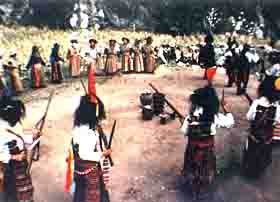Kexigela
Kexigela (《克西格拉》) is a ritual dance of the Qiang Ethnic Group.
The Qiang people, who now live in the Minshan area of northern Sichuan, have the oldest history of all of China's ethnic groups, and is one that still preserves its original customs to today.
The ancient nomadic Di and Qiang tribes once lived on the vast lands in north and northwest China. Over a period of more than 5,000 years, they experienced wars, annexation and separation as well as incessant migration, thereby integrating with many local clans and tribes. As a result, over half of China’s 56 ethnic groups have some amounts of Qiang blood. As for the formerly populous Di and Qiang tribes, they gradually developed into a minority ethnic group, inhabiting the Minshan area of northern Sichuan.
It is common knowledge that culture and customs are enriched by exchanges and integration among different ethnic groups. Although the Qiang have their own language, they have no written text. But because they live in close proximity to Tibetans, there is much Tibetan influence in terms of customs and religion, songs and dances, and sacrificial and worship rituals. Even so, the Qiang people have kept their unique customs and traditions, much of which is manifested in their architecture, sacrificial rituals, legends, folk art and craft, and songs and dances.
The Kexigela or "armor dance" is a ritual dance performed during sacrificial ceremonies. Traditionally, the dance was performed before soldiers went out to battle or during memorial events held for deceased revered elders or national heroes.
Sichuan Province boasts mountains and rivers and is famous for its intricate topography. If you want to enjoy Qiang singing and dancing, start out from Chengdu towards Maoxian County, capital of the Sichuan Tibetan and Qiang Autonomous Prefecture. From there, make your way to the Qiang communities among the Minshan Mountains.
However, to marvel at richness of Kexigela, you would need an extra day to traverse the long roads ranging from asphalt to pebble to dirt tracks, and a meandering footpath before finally reaching the "Qionglong" of the Qiang people, located at the top of a mountain range in Xi’er Guazi Stockade, Mawo Township, in the Xi’er Area.
The Qionglong was built by the ancient Qiang. It is considered an architectural wonder unparalleled anywhere in the world. It serves as a protection to the gray stone houses beneath it which are where the Qiang people reside. Roofs and windows are adorned with bright red peppers and golden corn, which add vigor to the white stone. Each house keeps a pile of white stones of different sizes in honor of the God of White Stone.
According to legend, while the ancient Qiang were warring with another tribe, the God of White Stone intervened to save them from certain death.
The Qiang people are known to be straightforward. And they love their song and dance. There are two main types of Qiang singing and dancing: those for sacrificial rituals, and those for entertainment. This ethnic group is polytheistic and believes that all beings have souls. To them, the departed have great influence on the living and therefore pay keen attention to funeral ceremonies.
According to Qiang tradition, wine is drunk before any sacrificial ceremony or dance.
In the Kexigela, a big wine jar and a large wooden barrel of boiled water are placed in the center of the dance area, usually a wheat threshing ground. Armed with a long-handled wooden spoon, a master of ceremonies calls for silence from the rest of the crowd and signals to the participating womenfolk to begin singing. Standing shoulder-to-shoulder and decked out in colorful Tibetan styled outfits, the women blend their voices in a melodious but melancholic chorus. As they sing, senior menfolk of the village make their way around the threshing ground, brandishing their knives and axes in the air, and take their positions beside the singing women.
The eldest woman starts the ceremony by sipping on the wine through a straw, followed by others in accordance with age, status and position in the hierarchy. The master of ceremonies fills the wine jar with boiled water after each person takes a sip of the wine, which actually prepares the wine for a further round of fermentation.
As the women continue singing, the men continue brandishing their weapons in the air and shouting “oh-ya, oh-wu”. Movements are slow and unhurried, which creates a solemn and respectful atmosphere, believed to be necessary for driving out evil spirits and protecting the dead persons' souls. The men make several rounds of the ceremonial grounds before they reform their lines. They pair up and perform movements to represent a mock battle.
The men retreat while the women continue singing, this time throwing their arms about and moving their bodies more vigorously. Their movements represent an expression of grief.
Kexigela or "armor dance" doesn't feature any special techniques or stunning scenery, but its aura is testament to an ancient tribe's spirit and culture.

